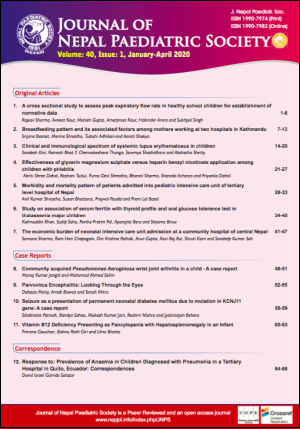A Cross Sectional Study to Assess Peak Expiratory Flow Rate in Healthy School Children for Establishment of Normative Data
DOI:
https://doi.org/10.3126/jnps.v40i1.27988Keywords:
normative data, peak expiratory flow rate, school childrenAbstract
Introduction: Peak Expiratory Flow Rate (PEFR) can be measured by cheap and portable instrument, peak flowmeter which is useful in detecting early asthmatic changes and monitoring the treatment response.
Methods: This study was conducted on 1000 normal healthy children of nine to 14 years of age of either sex from various schools of Faridkot district in South West Punjab, India. Anthropometry was done and PEFR was measured using Mini Bell Peak Flow Meter. Linear regression analysis was done and normograms were constructed.
Results: Linear regression equations were derived for PEFR with height, weight, BSA and BMI in boys and girls. The most significant correlation was seen with height (r = 0.527 in boys, r = 0.410 in girls) followed by body surface area (r = 0.506 in boys, r = 0.296 in girls). Body mass index had negative correlation (r = -0.200) with PEFR in girls. Nomograms were constructed on basis of linear regression equations of PEFR with height (-46.67 + 2.02 x height for boys, -12.64 + 1.50 x height for girls) and BSA (82.02 + 137.2 x BSA for boys, 96.61 + 88.11 x BSA for girls)
Conclusion: There is need for nomogram for each region so that personal value of PEFR can be compared to normal reference population and also with predicted value from regression equation as PEFR varies from region to region. The nomograms and regression equations derived from this study can be useful for predicting normal values of PEFR of children of South West Punjab.
Downloads
Downloads
Published
How to Cite
Issue
Section
License
Authors who publish with this journal agree to the following terms:
Authors retain copyright and grant the journal right of first publication with the work simultaneously licensed under a Creative Commons Attribution License that allows others to share the work with an acknowledgement of the work's authorship and initial publication in this journal.
Authors are able to enter into separate, additional contractual arrangements for the non-exclusive distribution of the journal's published version of the work (e.g., post it to an institutional repository or publish it in a book), with an acknowledgement of its initial publication in this journal.
Authors are permitted and encouraged to post their work online (e.g., in institutional repositories or on their website) prior to and during the submission process, as it can lead to productive exchanges, as well as earlier and greater citation of published work (See The Effect of Open Access).



